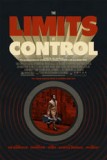| Reviews & Columns |
|
Reviews DVD TV on DVD Blu-ray 4K UHD International DVDs In Theaters Reviews by Studio Video Games Features Collector Series DVDs Easter Egg Database Interviews DVD Talk Radio Feature Articles Columns Anime Talk DVD Savant Horror DVDs The M.O.D. Squad Art House HD Talk Silent DVD
|
DVD Talk Forum |
|
|
| Resources |
|
DVD Price Search Customer Service #'s RCE Info Links |
|
Columns
|
|
|
Limits of Control, The
Jim Jarmusch has never been the most accommodating of directors, but he's really gone off the reservation with his new film, The Limits of Control. Oh, he's made films that were obtuse, or alienating. But he's never made one this self-defeatingly dull. It begins strongly enough, with a series of short, crisp, deliberate images, and there's some promise in its opening passages, even if you do wonder exactly how long it can get by on cool music, striking visuals, and the chiseled features of star Issach De Bankole. Jarmusch apparently thinks that'll do for 116 minutes. You keep waiting for the movie to start, and then it's over.
Here's what happens: The "Lone Man" (De Bankole) goes somewhere, via a plane or a train. He checks into a hotel. He meditates. He then meets a contact, who greets him by saying "You don't speak Spanish, right?" They proceed to either spout New Age-y non-sequiturs at him, or give him oblique instructions followed by New Age-y non-sequiturs. They exchange boxes of matches, he reads a note inside the box, he eats the note, and then he gets on the next plane or train, and the whole thing starts over again. This happens like ten times, and then he goes to kill Bill Murray, and then we can go home.
What the hell is Jarmusch up to here? He gives us nothing (no names, no motivations, no characterizations), aside from the most inactive action movie of all time--which is something, I suppose. Occasionally people we know pop up, and we hope something will happen, but we're wrong. They're like guest stars that come by to play the same tired scene and fail at drumming up some interest. Tilda Swinton turns up in a trenchcoat, cowboy hat, white fright wig, and clear umbrella, and our hearts sink, because when you give someone a costume that odd and elaborate, it's because they don't have a character to play so you have to give them something--for them to do, and for us to latch on to. It's the only way we remember anyone; she's the cowboy hat lady, he's the Mexican guy, she's the naked lady, etc. It doesn't help that Jarmusch has everyone utilize the same kind of odd, flat, disaffected line readings; the only actors to make any impression whatsoever are Murray and John Hurt, and they've each got two to three minutes of screen time.
The monotony, meanwhile, is downright numbing; when De Bankole changes his suit a third of the way in, we're so itchy for something to happen, it plays like a seismic event. By the time the film crawled into its third act, I was honestly wondering if Jarmusch just wanted an excuse to go to Spain, so he pounded out a script on a rainy Sunday. It's full of irritating repetition and inexplicable moments; in one of the endless parade of café scenes, Swinton starts talking about old movies, and says "Sometimes in films, I like it when people just sit there, not saying anything," so of course they then have to do that for a while; it's an embarrassingly obvious and phony beat in a picture full of them.
Much of it is the kind of self-consciously "arty" cinema that keeps regular filmgoers out of the art houses. "Everything is imaginary," poor Gael Garcia Bernal has to say, "I think this reflection is more present than I am." This is the kind of junk that first-year philosophy students say when they're stoned and trying to sound like deep thinkers. It would seem it's easier to make a film full of pseudo-metaphysical epigrams than to construct a smart, well-structured narrative with some snap and something for an audience to engage in.
It is worth noting that the cinematography, by the great Christopher Doyle, is just lovely--the color is smashing, from the blood red elevator to de Bankole's cool blue suit. Likewise, the music has to do much of the heavy lifting, and the cues are perfect. But it's at the service of nothing. I was excited about The Limits of Control; in his last two features (Ghost Dog and Broken Flowers), Jarmusch really seemed to be on to something, bringing his distinctive, off-kilter style to traditional stories and making something fresh and new. I liked that the trailer didn't give the whole film away, as so many trailers do. I showed that trailer to my wife, who said, "It looks interesting. What's it about?" I told her I didn't know. Come to find out, neither does Jarmusch.
Jason lives in New York. He holds an MA in Cultural Reporting and Criticism from NYU.
|
| Popular Reviews |
| Sponsored Links |
|
|
| Sponsored Links |
|
|
| Release List | Reviews | Shop | Newsletter | Forum | DVD Giveaways | Blu-Ray | Advertise |
|
Copyright 2024 DVDTalk.com All Rights Reserved. Legal Info, Privacy Policy, Terms of Use,
Manage Preferences,
Your Privacy Choices | |||||||











